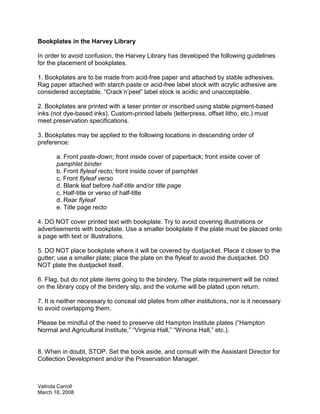Bookplates
- 1. Bookplates in the Harvey Library In order to avoid confusion, the Harvey Library has developed the following guidelines for the placement of bookplates. 1. Bookplates are to be made from acid-free paper and attached by stable adhesives. Rag paper attached with starch paste or acid-free label stock with acrylic adhesive are considered acceptable. âCrackânâpeelâ label stock is acidic and unacceptable. 2. Bookplates are printed with a laser printer or inscribed using stable pigment-based inks (not dye-based inks). Custom-printed labels (letterpress, offset litho, etc.) must meet preservation specifications. 3. Bookplates may be applied to the following locations in descending order of preference: a. Front paste-down; front inside cover of paperback; front inside cover of pamphlet binder b. Front flyleaf recto; front inside cover of pamphlet c. Front flyleaf verso d. Blank leaf before half-title and/or title page c. Half-title or verso of half-title d. Rear flyleaf e. Title page recto 4. DO NOT cover printed text with bookplate. Try to avoid covering illustrations or advertisements with bookplate. Use a smaller bookplate if the plate must be placed onto a page with text or illustrations. 5. DO NOT place bookplate where it will be covered by dustjacket. Place it closer to the gutter; use a smaller plate; place the plate on the flyleaf to avoid the dustjacket. DO NOT plate the dustjacket itself. 6. Flag, but do not plate items going to the bindery. The plate requirement will be noted on the library copy of the bindery slip, and the volume will be plated upon return. 7. It is neither necessary to conceal old plates from other institutions, nor is it necessary to avoid overlapping them. Please be mindful of the need to preserve old Hampton Institute plates (âHampton Normal and Agricultural Institute,â âVirginia Hall,â âWinona Hall,â etc.). 8. When in doubt, STOP. Set the book aside, and consult with the Assistant Director for Collection Development and/or the Preservation Manager. Valinda Carroll March 18, 2008

